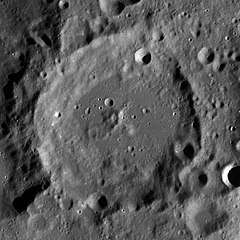Evershed (crater)
Evershed is a lunar impact crater on the far side of the Moon, named after the English solar astronomer John Evershed. It is located to the northeast of the larger crater Cockcroft, and to the north of the smaller Van den Bergh.
 LRO WAC mosaic | |
| Coordinates | 35.7°N 159.5°W |
|---|---|
| Diameter | 66 km |
| Depth | Unknown |
| Colongitude | 160° at sunrise |
| Eponym | John Evershed |
This crater has a worn outer rim that is somewhat indented and narrower along the eastern side where the formation overlays an older crater. The satellite crater Evershed R is attached to the outer southwest rim. There are small craters along the southern and southeast rim. The interior floor contains an irregular ridge near the midpoint and some rugged terrain in the south, with various tiny craterlets marking the remaining relatively level surface.
Satellite craters
By convention these features are identified on lunar maps by placing the letter on the side of the crater midpoint that is closest to Evershed.
| Evershed | Latitude | Longitude | Diameter |
|---|---|---|---|
| C | 38.1° N | 156.7° W | 48 km |
| D | 38.8° N | 156.0° W | 49 km |
| E | 35.9° N | 158.3° W | 73 km |
| R | 35.1° N | 161.2° W | 31 km |
| S | 34.9° N | 162.6° W | 45 km |
References
- Andersson, L. E.; Whitaker, E. A. (1982). NASA Catalogue of Lunar Nomenclature. NASA RP-1097.CS1 maint: ref=harv (link)
- Blue, Jennifer (July 25, 2007). "Gazetteer of Planetary Nomenclature". USGS. Retrieved 2007-08-05.CS1 maint: ref=harv (link)
- Bussey, B.; Spudis, P. (2004). The Clementine Atlas of the Moon. New York: Cambridge University Press. ISBN 978-0-521-81528-4.CS1 maint: ref=harv (link)
- Cocks, Elijah E.; Cocks, Josiah C. (1995). Who's Who on the Moon: A Biographical Dictionary of Lunar Nomenclature. Tudor Publishers. ISBN 978-0-936389-27-1.CS1 maint: ref=harv (link)
- McDowell, Jonathan (July 15, 2007). "Lunar Nomenclature". Jonathan's Space Report. Retrieved 2007-10-24.CS1 maint: ref=harv (link)
- Menzel, D. H.; Minnaert, M.; Levin, B.; Dollfus, A.; Bell, B. (1971). "Report on Lunar Nomenclature by the Working Group of Commission 17 of the IAU". Space Science Reviews. 12 (2): 136–186. Bibcode:1971SSRv...12..136M. doi:10.1007/BF00171763.CS1 maint: ref=harv (link)
- Moore, Patrick (2001). On the Moon. Sterling Publishing Co. ISBN 978-0-304-35469-6.CS1 maint: ref=harv (link)
- Price, Fred W. (1988). The Moon Observer's Handbook. Cambridge University Press. ISBN 978-0-521-33500-3.CS1 maint: ref=harv (link)
- Rükl, Antonín (1990). Atlas of the Moon. Kalmbach Books. ISBN 978-0-913135-17-4.CS1 maint: ref=harv (link)
- Webb, Rev. T. W. (1962). Celestial Objects for Common Telescopes (6th revised ed.). Dover. ISBN 978-0-486-20917-3.CS1 maint: ref=harv (link)
- Whitaker, Ewen A. (1999). Mapping and Naming the Moon. Cambridge University Press. ISBN 978-0-521-62248-6.CS1 maint: ref=harv (link)
- Wlasuk, Peter T. (2000). Observing the Moon. Springer. ISBN 978-1-85233-193-1.CS1 maint: ref=harv (link)
